Isometric Posterior Chain Peak Force Recovery Response Following Match-Play in Elite Youth Soccer Players: Associations with Relative Posterior Chain Strength
Abstract
1. Introduction
2. Methods
2.1. Subjects
2.2. Procedures
2.3. Testing Procedures
2.4. Statistical Analysis
3. Results
3.1. IPC-F at 30° and 90°
3.2. Relationship between Pre-Match IPC-F and IPC-F Change Following Match-Play
4. Discussion
4.1. IPC-F Fatigue-Recovery Response and Angle-Specific Differences
4.2. 72 h Post-Match—“Positive Adaptation”
4.3. Variation in IPC-F and VariaVariability in IPC-F Response
5. Conclusions
Author Contributions
Funding
Conflicts of Interest
References
- Ekstrand, J.; Hagglund, M.; Walden, M. Injury incidence and injury patterns in professional football—the UEFA injury study. Br. J. Sports Med. 2010, 45, 553–558. [Google Scholar] [CrossRef] [PubMed]
- Bourne, M.N.; Opar, D.A.; Williams, M.D.; Shield, A.J. Eccentric Knee Flexor Strength and Risk of Hamstring Injuries in Rugby Union: A Prospective Study. Am. J. Sports Med. 2015, 43, 2663–2670. [Google Scholar] [CrossRef] [PubMed]
- Fousekis, K.; Tsepis, E.; Poulmedis, P.; Athanasopoulos, S.; Vagenas, G. Intrinsic risk factors of non-contact quadriceps and hamstring strains in soccer: A prospective study of 100 professional players. Br. J. Sports Med. 2011, 45, 709–714. [Google Scholar] [CrossRef] [PubMed]
- Gabbett, T.J.; Ullah, S. Relationship between running loads and soft-tissue injury in elite team sport athletes. J. Strength Cond. Res. 2011, 26, 953–960. [Google Scholar] [CrossRef] [PubMed]
- Carling, C.; Bradley, P.; McCall, A.; Dupont, G. Match-to-match variability in high-speed running activity in a professional soccer team. J. Sports Sci. 2016, 34, 2215–2223. [Google Scholar] [CrossRef] [PubMed]
- Nedelec, M.; McCall, A.; Carling, C.; Legall, F.; Berthoin, S.; Dupont, G. Recovery in soccer: Part I—post-match fatigue and time course of recovery. J. Sports Med. 2012, 42, 997–1015. [Google Scholar]
- Soligard, T.; Alonso, J.M.; Bahr, R.; Clarsen, B.; Dijkstra, H.P.; Gabbett, T.; Gleeson, M.; Hagglund, M.; Hutchinson, M.R.; Rensburg, C.J.V.; et al. How much is too much? (Part 1) International Olympic Committee consensus statement on load in sport and risk of injury. Br. J. Sports Med. 2016, 50, 1030–1041. [Google Scholar] [CrossRef]
- Junge, A.; Dvorak, J. Soccer injuries: A review on incidence and prevention. Sports Med. 2004, 34, 929–938. [Google Scholar] [CrossRef]
- Ekstrand, J.; Hagglund, M.; Walden, M. Epidemiology of muscle injuries in professional football (Soccer). Am. J. Sports Med. 2011, 39, 1226–1232. [Google Scholar] [CrossRef]
- Buchheit, M.; Mendez-Villanueva, A.; Simpson, B.M.; Bourdon, P.C. Match Running performance and fitness in youth soccer. Int. J. Sports Med. 2010, 31, 818–825. [Google Scholar] [CrossRef]
- Nedelec, M.; McCall, A.; Carling, C.; Legall, F.; Berthoin, S.; Dupont, G. The influence of soccer playing actions on the recovery kinetics after a soccer match. J. Strength Cond. Res. 2014, 28, 1517–1522. [Google Scholar] [CrossRef] [PubMed]
- Thomas, K.; Dent, J.; Howatson, G.; Goodall, S. Etiology and recovery of neuromuscular fatigue after simulated soccer match play. Med. Sci. Sports Exerc. 2017, 49, 955–964. [Google Scholar] [CrossRef] [PubMed]
- Thorlund, J.B.; Aagaard, P.; Madsen, K. Rapid muscle force capacity changes after soccer match play. Int. J. Sports Med. 2009, 30, 273–278. [Google Scholar] [CrossRef] [PubMed]
- Krustrup, P.; Ortenblad, N.; Nielsen, J.; Nybo, L.; Gunnarsson, T.P.; Iaia, F.M.; Madsen, K.; Stephens, F.; Greenhaff, P.; Bangsbo, J. Maximal voluntary contraction force, SR function and glycogen resynthesis during the first 72 h after a high-level competitive soccer game. Eur. J. Appl. Physiol. 2011, 111, 2987–2995. [Google Scholar] [CrossRef] [PubMed]
- McCall, A.; Nedelec, M.; Carling, C.; Le Gall, F.; Berthoin, S.; Dupont, G. Reliability and sensitivity of a simple isometric posterior lower limb muscle test in professional football players. J. Sports Sci. 2015, 33, 1298–1304. [Google Scholar] [CrossRef]
- Raastad, T.; Owe, S.G.; Paulsen, G.; Enns, D.; Overgaard, K.; Crameri, R.; Kiil, S.; Belcastro, A.; Bergersen, L.H.; Hallén, J. Changes in calpain activity, muscle structure, and function after eccentric exercise. Med. Sci. Sports Exerc. 2010, 42, 86–95. [Google Scholar] [CrossRef]
- Wollin, M.; Thorborg, K.; Pizzari, T. The acute effect of match play on hamstring strength and lower limb flexibility in elite youth football players. Scand. J. Med. Sci. Sports. 2017, 27, 282–288. [Google Scholar] [CrossRef]
- De Hoyo, M.; Cohen, D.D.; Sañudo, B.; Carrasco, L.; Álvarez-Mesa, A.; Del Ojo, J.J.; Domínguez-Cobo, S.; Mañas, V.; Otero-Esquina, C. Influence of football match time-motion parameters on recovery time course of muscle damage and jump ability. J. Sports Sci. 2016, 34, 1363–1370. [Google Scholar] [CrossRef]
- Johnston, R.D.; Gabbett, T.J.; Jenkins, D.G.; Hulin, B.T. Influence of physical qualities on post-match fatigue in rugby league players. J. Sci. Med. Sport 2015, 18, 209–213. [Google Scholar] [CrossRef]
- Thorpe, R.; Strudwick, A.; Buchheit, M.; Atkinson, G.; Drust, B.; Gregson, W. Monitoring fatigue during the in-season competitive phase in elite soccer players. Int. J. Sports Physiol. Perform. 2015, 10, 958–964. [Google Scholar] [CrossRef]
- Buchheit, M.; Cholley, Y.; Nagel, M.; Poulos, N. The Effect of Body Mass on Eccentric Knee-Flexor Strength Assessed With an Instrumented Nordic Hamstring Device (Nordbord) in Football Players. Int. J. Sports Physiol. Perform. 2016, 11, 721–726. [Google Scholar] [CrossRef] [PubMed]
- Elite Performance—Premier League. Available online: https://www.premierleague.com/youth/elite-performance (accessed on 25 July 2019).
- Rothman, K.J. No adjustments are needed for multiple comparisons. Epidemiology 1990, 1, 43–46. [Google Scholar] [CrossRef] [PubMed]
- Ament, W.; Verkerke, G.J. Exercise and Fatigue. Sports Med. 2009, 39, 389–422. [Google Scholar] [CrossRef] [PubMed]
- Matinlauri, A.; Alcaraz, P.E.; Freitas, T.T.; Mendiguchia, J.; Abedin-Maghanaki, A.; Castillo, A.; Martínez-Ruiz, E.; Carlos-Vivas, J.; Cohen, D.D. A comparison of the isometric force fatigue-recovery profile in two posterior chain lower limb tests following simulated soccer competition. PLoS ONE 2019, 14, 16. [Google Scholar] [CrossRef] [PubMed]
- Schache, A.G.; Crossley, K.M.; Macindoe, I.G.; Fahrner, B.B.; Pandy, M.G. Can a clinical test of hamstring strength identify football players at risk of hamstring strain? Knee Surg. Sports Traumatol. Arthrosc. 2011, 19, 38–41. [Google Scholar] [CrossRef] [PubMed]
- Read, P.J.; Turner, A.N.; Clarke, R.; Applebee, S.; Hughes, J. Knee Angle Affects Posterior Chain Muscle Activation During an Isometric Test Used in Soccer Players. Sports 2019, 7, 13. [Google Scholar] [CrossRef]
- Cohen, D.D.; Zhao, B.; Okwera, B.; Matthews, M.J.; Delextrat, A. Angle-specific eccentric hamstring fatigue after simulated soccer. Int. J. Sports Physiol. Perform. 2015, 10, 325–331. [Google Scholar] [CrossRef] [PubMed]
- Onishi, H.; Yagi, R.; Oyama, M.; Akasaka, K.; Ihashi, K.; Handa, Y. EMG-angle relationship of the hamstring muscles during maximum knee flexion. J. Electromyogr. Kinesiol. 2002, 12, 399–406. [Google Scholar] [CrossRef]
- Cheung, K.; Hume, P.; Maxwell, L. Delayed onset of muscle soreness: Treatment strategies and performance factors. Sports Med. 2003, 33, 145–164. [Google Scholar] [CrossRef]
- Harrison, P.W.; James, L.P.; McGuigan, M.R.; Jenkins, D.G.; Kelly, V.G. Resistance Priming to Enhance Neuromuscular Performance in Sport: Evidence, Potential Mechanisms and Directions for Future Research. Sports Med. 2019, 49, 1499–1514. [Google Scholar] [CrossRef]
- Morgans, R.; Di Michele, R.; Drust, B. Soccer Match Play as an Important Component of the Power-Training Stimulus in Premier League Players. Int. J. Sports Physiol. Perform. 2018, 13, 665–667. [Google Scholar] [CrossRef] [PubMed]
- Silva, J.R.; Rumpf, M.C.; Hertzog, M.; Castagna, C.; Farooq, A.; Girard, O. Acute and Residual Soccer Match-Related Fatigue: A Systematic Review and Meta-analysis. Sports Med. 2017, 48, 539–583. [Google Scholar] [CrossRef] [PubMed]
- Salvo, D.V.; Baron, R.; Tschan, H.; Calderon-Montero, F.J.; Bachl, N.; Pigozzi, F. Performance characteristics according to playing position in elite soccer. Int. J. Sports Med. 2007, 28, 222–227. [Google Scholar] [CrossRef] [PubMed]
- Ryan, D.; Lewin, C.; Forsythe, S.; McCall, A. Developing World-Class Soccer Players: An Example of the Academy Physical Development Program from an English Premier League Team. Strength Cond. J. 2017, 40, 2–11. [Google Scholar] [CrossRef]
- Abbott, W.; Brickley, G.; Smeeton, N.J. Physical demands of playing position with English Premier League academy soccer. J. Hum. Sport Exerc. 2018, 13, 285–295. [Google Scholar] [CrossRef]
- Tonnessen, E.; Hem, E.; Leirstein, S.; Haugen, T.; Seiler, S. Maximal aerobic power characteristics of male professional soccer players, 1989–2012. Int. J. Sports Physiol. Perform. 2013, 8, 323–329. [Google Scholar] [CrossRef] [PubMed]
- Ricoy, J.R.; Encinas, A.R.; Cabello, A.; Madero, S.; Arenas, J. Histochemical study of the vastus lateralis muscle fibre types of athletes. J. Physiol. Bio. 1998, 54, 41–48. [Google Scholar]
- Friden, J.; Sjostrom, M.; Ekbolm, B. Myofibrillar Damage Following Intense Eccentric Exercise in Man. Int. J. Sports Med. 1983, 3, 170–176. [Google Scholar] [CrossRef]
- Magal, M.; Dumke, C.L.; Urbiztondo, Z.G.; Cavill, M.J.; Triplett, N.T.; Quindry, J.C.; McBride, J.M.; Epstein, Y. Relationship between serum creatine kinase activity following exercise-induced muscle damage and muscle fibre composition. J. Sports Sci. 2010, 28, 257–266. [Google Scholar] [CrossRef]
- Johnston, R.D.; Gabbett, T.J.; Jenkins, D.G. Influence of playing standard and physical fitness on activity profiles and post-match fatigue during intensified junior rugby league competition. Sports Med. Open. 2015, 1, 18. [Google Scholar] [CrossRef]
- Owen, A.; Dunlop, G.; Rouissi, M.; Chtara, M.; Paul, D.; Zouhal, H.; Wong del, P. The relationship between lower-limb strength and match-related muscle damage in elite level professional European soccer players. J. Sports Sci. 2015, 33, 2100–2105. [Google Scholar] [CrossRef] [PubMed]
- Small, K.; McNaughton, L.R.; Greig, M.; Lohkamp, M.; Lovell, R. Soccer fatigue, sprinting and hamstring injury risk. Int. J. Sports Med. 2019, 30, 573–578. [Google Scholar] [CrossRef] [PubMed]
- Bishop, D.; Edge, J.; Goodman, C. Muscle buffer capacity and aerobic fitness are associated with repeated-sprint ability in women. Eur. J. Appl. Phyiol. 2004, 92, 540–547. [Google Scholar] [CrossRef] [PubMed]
- Delextrat, A.; Piquet, M.J.; Cohen, D.D. Strength-Endurance Training Reduces the Hamstrings Strength Decline Following Simulated Football Competition in Female Players. Front. Physiol. 2018, 24, 1059. [Google Scholar] [CrossRef]
- Thorpe, R.T.; Atkinson, G.; Drust, B.; Gregson, W. Monitoring Fatigue Status in Elite Team-Sport Athletes: Implications for Practice. Int. J. Sports Physiol. Perform. 2017, 12, S2-27–S2-34. [Google Scholar] [CrossRef]
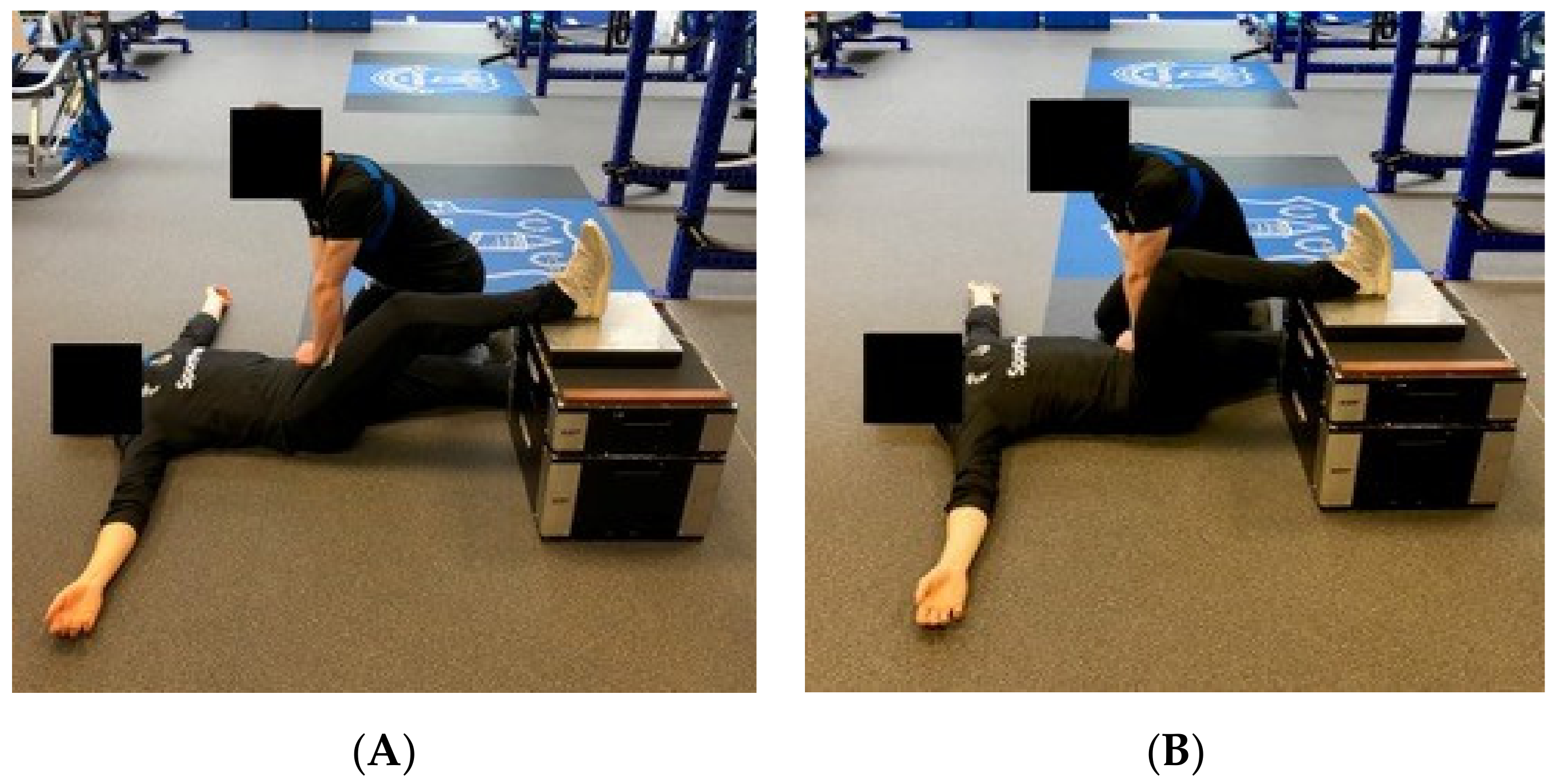
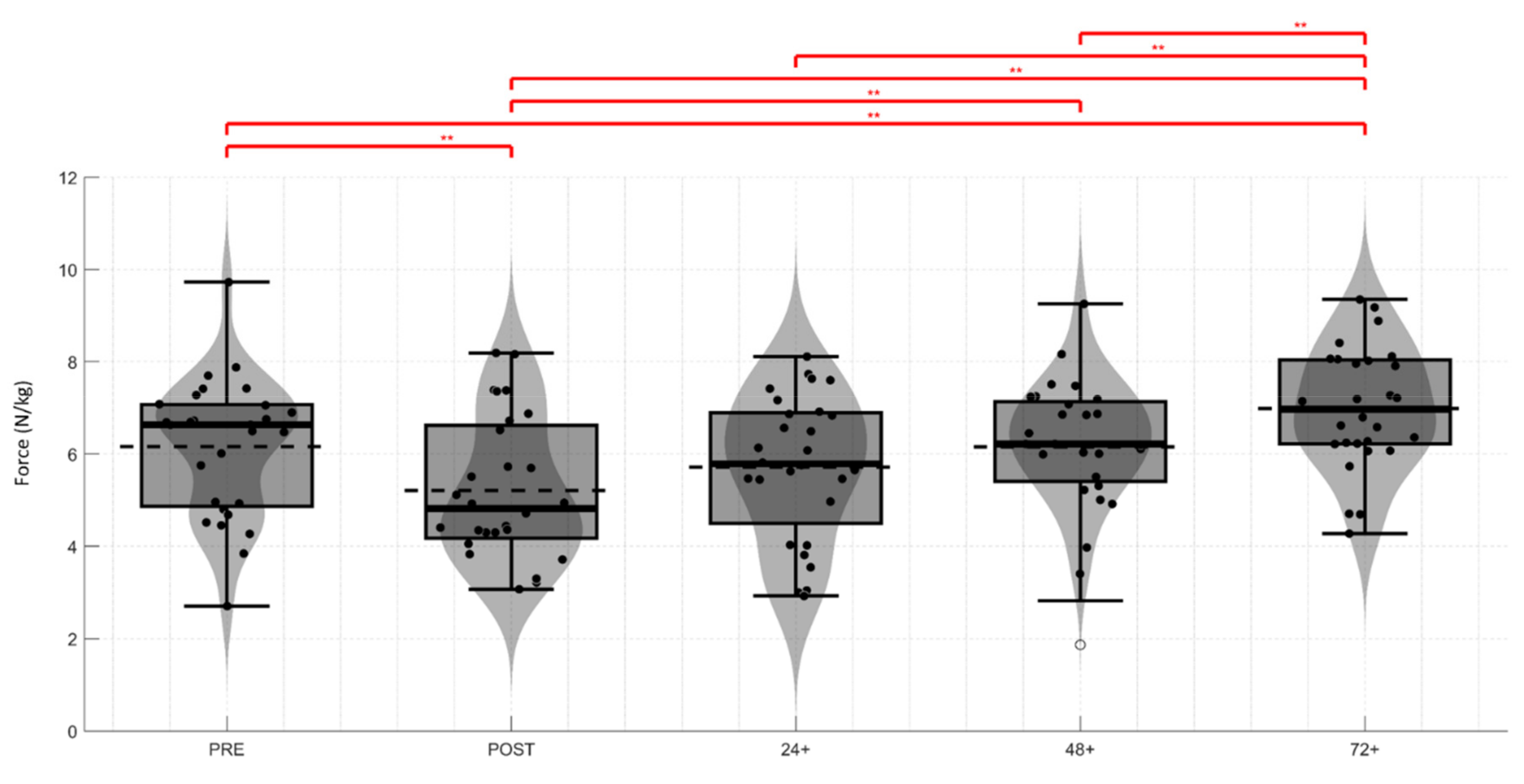
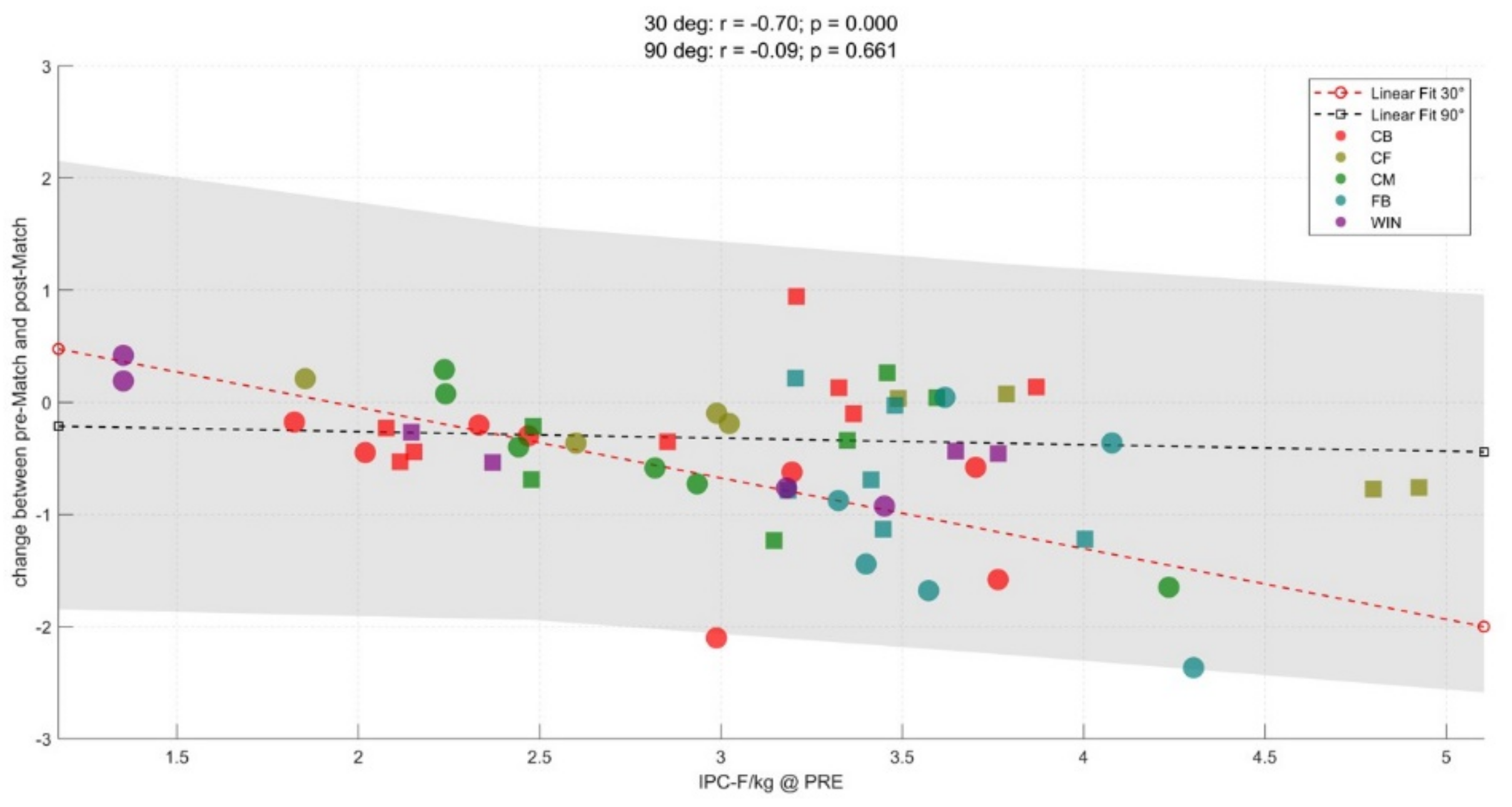
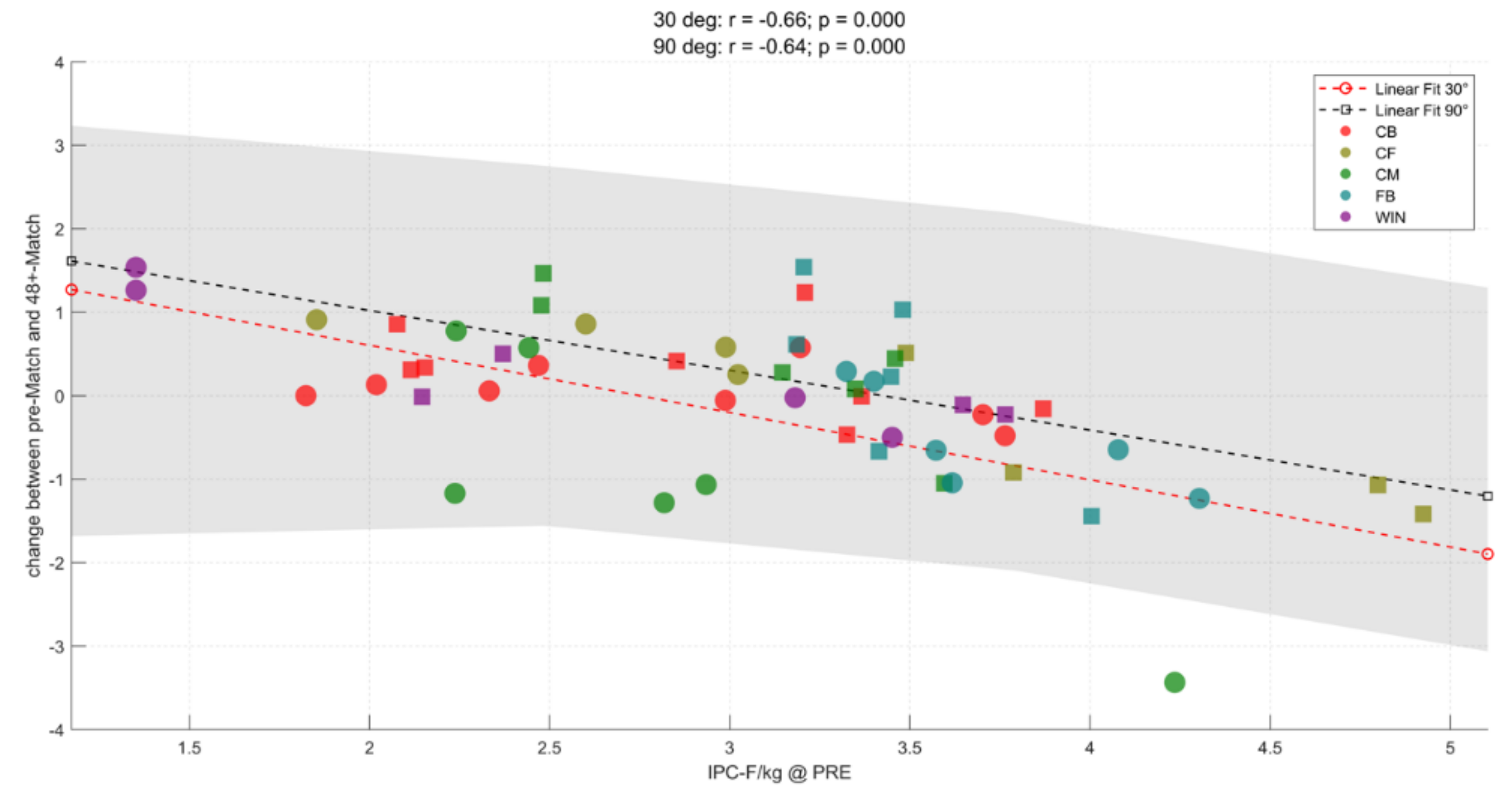
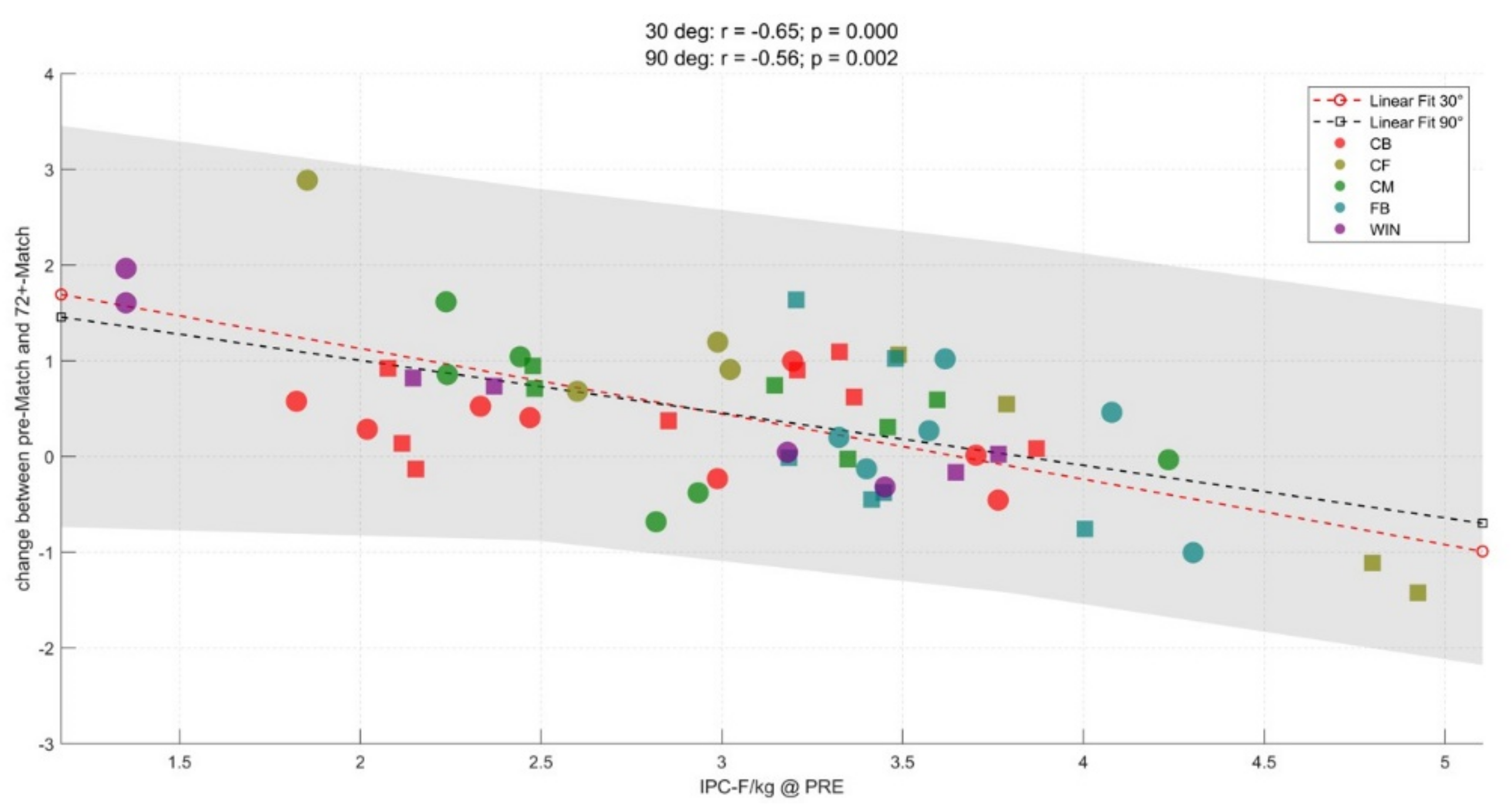
| Pre | Post | Δ vs Pre Match (%) | +24 | Δ vs Pre Match (%) | +48 | Δ vs Pre Match (%) | +72 | Δ vs Pre Match (%) | |
|---|---|---|---|---|---|---|---|---|---|
| 30° | 5.8 (1.5) | 4.6 (1.2) | −20.7 | 5.1 (1.6) | −12.1 | 5.6 (1.5) | −3.4 | 6.8 (1.3) | +17.2 |
| 90° | 6.5 (1.4) | 5.8 (1.7) | −10.8 | 6.3 (1.2) | −3.1 | 6.8 (1.2) | +3.1 | 7.1 (1.3) | +9.2 |
© 2019 by the authors. Licensee MDPI, Basel, Switzerland. This article is an open access article distributed under the terms and conditions of the Creative Commons Attribution (CC BY) license (http://creativecommons.org/licenses/by/4.0/).
Share and Cite
Constantine, E.; Taberner, M.; Richter, C.; Willett, M.; Cohen, D.D. Isometric Posterior Chain Peak Force Recovery Response Following Match-Play in Elite Youth Soccer Players: Associations with Relative Posterior Chain Strength. Sports 2019, 7, 218. https://doi.org/10.3390/sports7100218
Constantine E, Taberner M, Richter C, Willett M, Cohen DD. Isometric Posterior Chain Peak Force Recovery Response Following Match-Play in Elite Youth Soccer Players: Associations with Relative Posterior Chain Strength. Sports. 2019; 7(10):218. https://doi.org/10.3390/sports7100218
Chicago/Turabian StyleConstantine, Emma, Matt Taberner, Chris Richter, Matthew Willett, and Daniel D. Cohen. 2019. "Isometric Posterior Chain Peak Force Recovery Response Following Match-Play in Elite Youth Soccer Players: Associations with Relative Posterior Chain Strength" Sports 7, no. 10: 218. https://doi.org/10.3390/sports7100218
APA StyleConstantine, E., Taberner, M., Richter, C., Willett, M., & Cohen, D. D. (2019). Isometric Posterior Chain Peak Force Recovery Response Following Match-Play in Elite Youth Soccer Players: Associations with Relative Posterior Chain Strength. Sports, 7(10), 218. https://doi.org/10.3390/sports7100218





